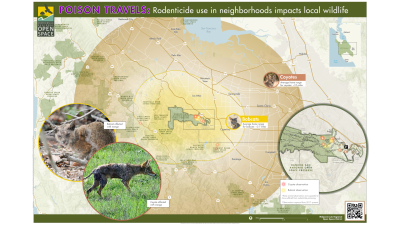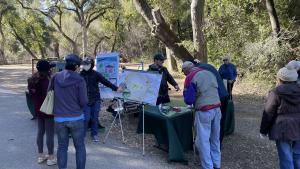After numerous sick animals were observed in Midpen preserves around 2013, California Department of Fish and Wildlife (CDFW), with assistance from Midpen staff, linked the illness and death of many bobcats to second-generation anticoagulant rodenticides (SGARs). Bobcats and other predators like coyotes, hawks, owls and kites can eat hundreds of mice and rats a year. If the preyed upon rodents have consumed SGARs or other rodenticides, those toxins can accumulate in a predator's body, weakening their immune systems and making them more susceptible to diseases like mange. If rodenticides are consumed in large enough quantities, they can be fatal to wildlife.
Midpen began educating preserve neighbors about the effects of commonly available pesticides on wildlife and joined the ongoing effort to lobby the California State Legislature in limiting their use. In 2014, the legislature passed AB 2657, limiting access to SGARs to individuals with state-issued pest control licenses. Midpen also took action with its award-winning IPM Program, mandating the use of non-chemical techniques first whenever possible to protect human and environmental health. Additionally, in 2020, Midpen supported AB 1788, “The California Ecosystems Protection Act,” which prohibits most uses of SGARs. In 2024, Midpen supported AB 2552, which prohibits the use of first-generation anticoagulant rodenticides which also impact wildlife.
In recent years, there have been multiple instances of unhealthy coyotes and bobcats exhibiting symptoms of mange. One bobcat and one coyote were found dead at Rancho San Antonio and later tested positive for rodenticide exposure. Despite legislative efforts to reduce use, rodenticides are still being used. A recent CDFW study found that between 70 to 90% of tested wildlife were found to have SGARs in their systems. Midpen continues to work with other agencies and organizations to limit rodenticides and promote alternative pest control methods.

What can you do?
There are more effective means of rodent control through property control and natural solutions rather than using rodenticides. Remember, preventing rodents from establishing on your property is much more effective and safer to wildlife than use of pesticides.
You can help by hardening your home against rodents by sealing any openings or entrances to your residence.
Remove rodent-friendly habitats such as English ivy, iceplant and other natural habitats. Clear any fallen fruit as to not attract rodents
Remove rodent access to any food sources such as pet food, chicken coops, garbage and compost. Remember, rodents can gnaw through thin plastic or cardboard containers.
When active pest control is necessary, consider manual traps such as snap and box traps to control rodent populations in your neighborhood.
Visit the website of Raptors Are the Solution, a Midpen partner, for more information.
Install an owl box, to attract natural predators who limit rodent populations. Click here for directions on building and installing a barn owl box.
If working with a pest control company, request to review and approve a list of any pesticides that are being used. One common compound, known as Diphacinone, can harm non-target wildlife. Check the active ingredients of proposed pesticides to avoid this compound.





